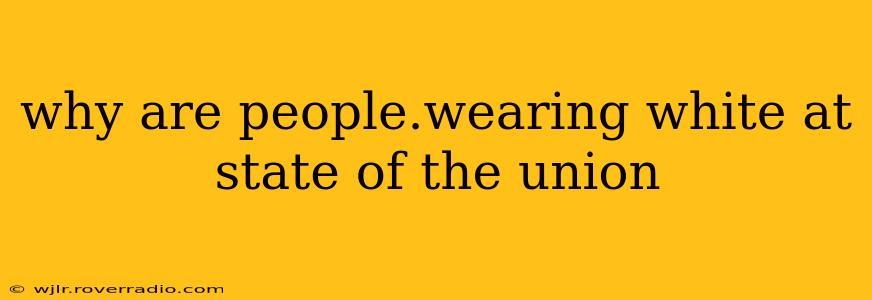Why Are People Wearing White at the State of the Union?
The sight of numerous individuals clad in white at the State of the Union address has become a recurring phenomenon, sparking curiosity and prompting questions about its significance. This practice isn't a spontaneous fashion trend; it's a deliberate, symbolic act with a powerful history rooted in women's suffrage and the ongoing fight for women's rights.
What is the history of wearing white to the State of the Union?
The tradition of wearing white to the State of the Union traces its roots back to the women's suffrage movement of the early 20th century. White symbolized purity, virtue, and ultimately, the pursuit of a clean slate – a new era of equality. Suffragists famously wore white to rallies and demonstrations, making it a powerful visual representation of their cause. This visual association has persisted, and the color white continues to represent a collective call for change and empowerment.
Why do women wear white to the State of the Union?
The resurgence of wearing white to the State of the Union in recent years is directly linked to the ongoing fight for women's rights and equality. By donning white, women representatives and their supporters make a strong, unified statement demonstrating solidarity and a shared commitment to feminist ideals. It serves as a visible reminder of the historical struggle for women’s rights and a declaration that the fight for gender equality is far from over.
What does wearing white at the State of the Union represent?
Wearing white at the State of the Union represents a multitude of things:
- Solidarity: It showcases a united front of women who share a common goal – advancing women's rights and pushing for gender equality in all spheres of life.
- Power: The visual impact of a large group of women dressed in white is significant. It’s a powerful symbol of their collective strength and influence.
- Historical context: The choice of white directly links the present-day fight for equality to the historical struggles of suffragists, highlighting the continuing need for progress.
- Hope: The color white often symbolizes hope for a better future, reinforcing the optimistic message that equality is achievable.
- Visibility: The striking visual of women in white ensures the issue of women's rights gets attention and stays at the forefront of the national conversation.
Is it only women who wear white to the State of the Union?
While primarily associated with women, men have also occasionally joined in wearing white to show their support for women's rights and gender equality. This demonstrates a growing understanding and acceptance of the importance of gender equity within society as a whole.
What other symbolic actions are taken during the State of the Union?
Besides wearing white, other symbolic actions are taken during the State of the Union, often related to political statements or affiliations. These can include wearing specific colored ribbons, pins, or clothing items that reflect political alliances or stances on certain issues.
In conclusion, the practice of wearing white at the State of the Union is a powerful and deeply symbolic act. It's a continuation of a historical tradition, a declaration of solidarity, and a vibrant visual representation of the ongoing fight for gender equality and women's rights. The simple yet impactful choice of color speaks volumes, making it a significant and memorable part of the annual event.
